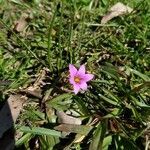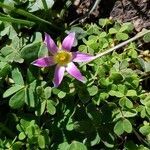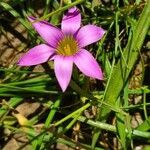Slender tufts. Corm c. 1 cm diam., globose, rounded at base where smooth brown tunic splits into acuminate teeth bent to one side. Leaves 10-30 cm × 1-2 mm, rush-like, compressed-cylindrical, narrowly grooved, dark shining green. Scapes hidden by sheathing leaf-bases, 2-4-(10) from each corm, 5-15 cm long, stouter than leaves, semiterete, arched over after flowering; spathe-valves 2, long-persistent, outer longer, greenish with fine brown veins, inner with membranous reddish-brown flecked margins. Flowers lilac-pink, rosy-cerise or magenta, with yellow centre and violet-blue band at throat, 1.5-2 cm long, to 3 cm diam.; tube very short; outer lobes greener on back than inner. Capsules c. long, short-cylindrical, scapes straightening when capsules mature. Seeds 2 mm long, reddish-brown, globose-triangular.
Plants 3–12(–30) cm. Corm tunicate, 5–15 mm diam.; tunic hard, woody, splitting above and below into acuminate segments, those below bent backward. Stems usually branched below ground level; branches (peduncles) aerial, suberect, becoming falcate, ultimately erect. Leaves (2–)6–9, much exceeding stem; blade 10–30 cm × ca. 1.5 mm. Spathes green or flushed with purple; outer 12–25 mm, margin narrow, membranous; inner margin brown-streaked, broad, membranous. Tepals pink to purple, usually pale yellow in cup, outer pale abaxially, main veins dark green to purple, lanceolate, 13–22 × 3–4 mm; perianth tube 2–3.5 mm; filaments ca. 5 mm; anthers ca. 4 mm; style branching opposite upper 1/3 anthers; branches ca. 2 mm, shorter than anther apices. Capsules 10–15 mm. Seeds ca. 2 mm diam.
Plants 150-600 mm long. Corm sub-globose, with curved acuminate basal teeth bent over a rounded base. Leaves basal, filiform to compressed cylindrical, 0.5-2.5 mm in diam. Bracts greenish or purplish, the inner with wide, brown or brown-streaked membranous margins. Flowers 15-48 mm long, magenta, pink, lilac-pink or white, often with a violet-blue throat, cup pale yellow to orange-yellow, outer segments variously coloured or marked on the backs. Perianth tube 2-8 mm long; segments 10-38 x 3-10 mm. Stamens 7-16 mm long; anthers 3-10 mm long, pale to golden-yellow, subequal to or longer than the filaments. Style 7-18 mm; stigmas below, above or at the anther tips. Capsules on peduncles which curve after flowering and straighten later.
A small herb. It keeps growing from year to year. It arises from a bulb under the ground. The leaves are narrow and linear. They are 30 cm long and grooved. They are like grass. They are very tough. They have a thickened edge and midrib. The base of the leaves sheaths the stem underground. There are up to 4 flowers from each corm. They are on a leaf free stem. The flowers are pink. They are like stars. They are supported by an unequal pair of sword shaped bracts. The fruit is a capsule with 3 sections. It has broad wrinkles. There are 10-30 seeds. The capsule opens widely into 3 blunt leathery lobes.
Perennial herb, geophyte, 0.1-0.4 m high; corm subglobose, with curved acuminate teeth; stem subterranean. Leaves 3-6, usually basal, narrowly 4-grooved. Bracts greenish or purplish, margins hardly visible, membranous. Flowers several, pink to magenta or white, often with a purplish zone around yellow cup; perianth tube 2-8 mm long, funnelshaped; tepals oblanceolate, 10-38 mm long, (sub)acute. Stamens erect; filaments 4-6 mm long, slightly pilose below; anthers 3-10 mm long, pale to golden-yellow. Style 7-18 mm long. Flowering time Apr.-Aug.
Cormous geophyte, 100-400 mm tall, corms round at base. Basal leaves several, narrowly 4-grooved. Flowers pink to purple, sometimes white, with yellow cup. Ripe capsules erect.
Cormous geophyte, 10-40 cm, corms rounded at base with coarse, bent teeth. Basal leaves several. Flowers pink to purple, sometimes white, with yellow cup. Ripe capsules erect.
See profiles for varieties.



